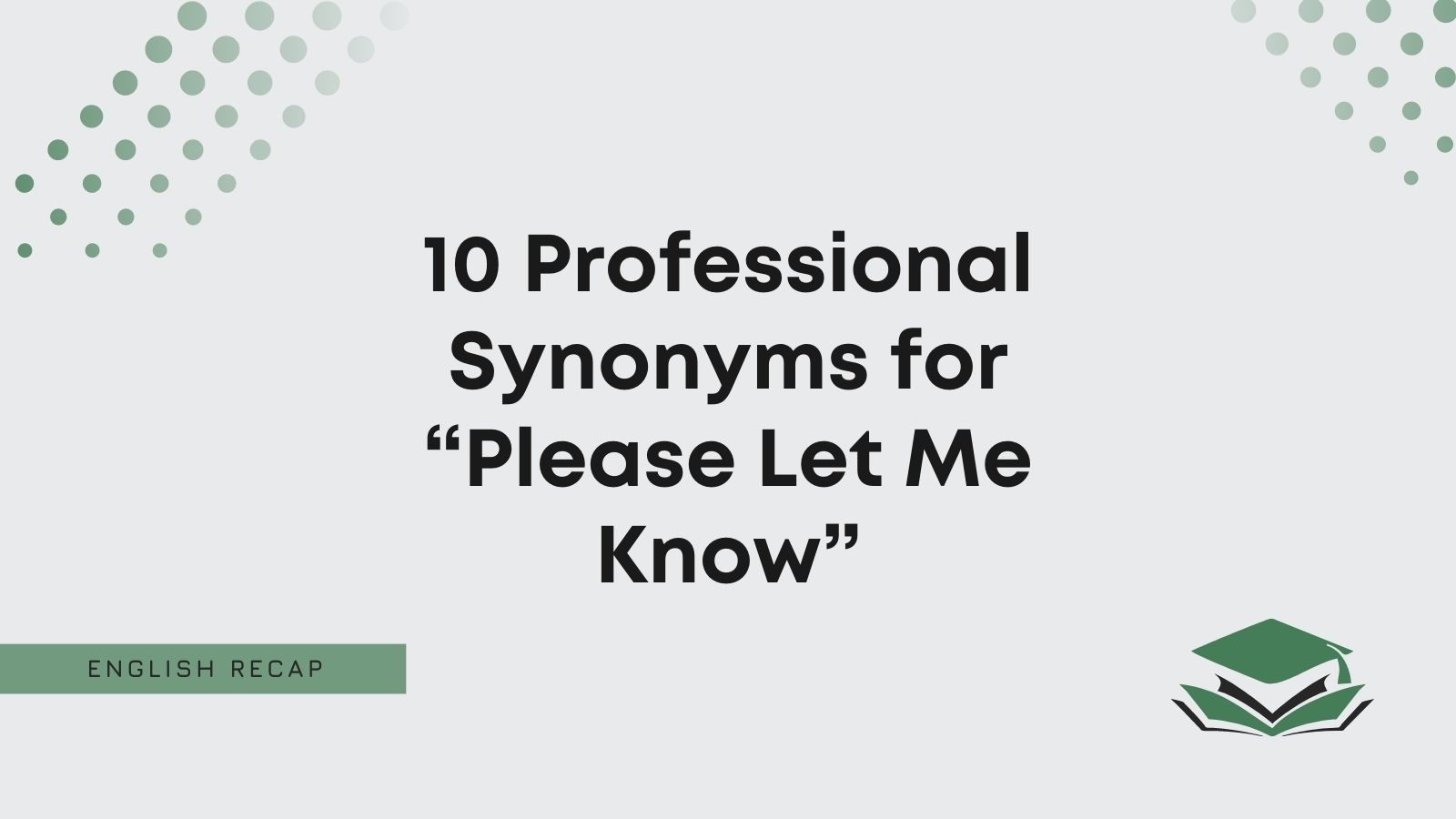There are many reasons to write “please let me know” in an email. Perhaps you’re seeking advice or setting up a meeting. Either way, are there more professional synonyms for “please let me know” that might help your business emails?
This article has gathered the best alternatives to show you how to say “please let me know” professionally.
Is It Professional to Say “Please Let Me Know”?
It is professional to say “please let me know.” It’s a very well-rounded phrase that shows you’d like someone to reply to you with information.
We recommend it because it’s polite and formal. You can’t go wrong with it in a professional email, and plenty of uses apply.
For example:
- Please let me know your availability.
- Please let me know what time suits your best.
- Can you please let me know your thoughts?
Pros
- It’s well-rounded and applies to many situations.
- It’s very polite.
Cons
- It’s quite a generic way to start an email.
- Some writers don’t like “let me know” in formal contexts as it sounds needy.
There’s nothing wrong with “please let me know.” It’s already one of the most well-rounded professional phrases in an email. However, it’s worth branching out and exploring your options to keep your writing interesting.
So, read on to learn other ways to say “please let me know.” We’ve also provided an example for each to demonstrate them in situations.
What to Say Instead of “Please Let Me Know”
- Please advise
- Please inform me
- Please tell me
- Please notify me
- Keep me updated
- Keep me up to date
- Please keep me posted
- Reach out
- Contact me
- Get in touch
1. Please Advise
Another way to say “please let me know” is “please advise.” It’s very useful in formal emails because it shows you’re seeking advice from the recipient. Generally, it works best when emailing your boss.
You won’t often ask a colleague to “advise” you on something. After all, it’s likely they have the same information as you. Instead, it’s more helpful to ask someone who knows more (i.e., a boss or supervisor) to “advise” you on your next steps.
Why not refer to this email example as well:
Dear Russell,
Could you please advise how you would like to proceed? I would like to know what our next steps are.
All the best,
Sarah Tanner
2. Please Inform Me
Another example of how to say “please let me know” in an email is “please inform me.” It shows you’re eager to learn new information from the recipient.
The idea is that they should keep you “informed” as soon as they have something new to say. Therefore, you’ll want to use it when emailing clients you’re working with. It shows you want to help them to the best of your ability.
Check out this email sample to see how it works:
Dear Rudy,
Please inform me if you have any questions. I’m happy to help, but I need to know what you think first.
Kind regards,
Rachel Green
3. Please Tell Me
A slightly simpler alternative is “please tell me.” You can use “tell me” instead of “let me know” in most business emails to show that you’d like someone to keep you in the loop.
“Tell me” might seem a bit conversational. However, it’s a very popular phrasal choice in most written contexts.
We highly recommend using it when emailing clients. It’s polite and professional, allowing you to build a good rapport with them.
Here’s a useful email example to show you how to use it:
Dear Mr. Merriweather,
Please tell me if this works for you. I’m keen to move forward with it, but I need you to be on board.
All the best,
Samuel Anderson
4. Please Notify Me
Perhaps you’re waiting on specific information to come through. You might need a client to notify you whenever that happens. So, it’s worth using “please notify me” in your emails to let them know that you expect an email when relevant.
Generally, “please notify me” shows that you expect someone to reply. They might not do so immediately, but you can use it to show that you’d like an update relating to the original email as soon as it appears.
You can also refer to this example:
Dear Katie,
Can you please notify me if you need anything else? I’m always happy to help. You only have to ask.
Kind regards,
Lewis Surtur
5. Keep Me Updated
You can also use “keep me updated” instead of “please let me know.” It shows that you’d appreciate being kept up to date with a client, especially if they have any questions they’d like to ask you.
That way, you can ensure that the client isn’t trying to do anything without your help. It sets you up as a reliable source for the client, allowing them to update you on their progress and how they’re getting on.
This sample email will also help you with it:
Dear Mr. Smith,
Please keep me updated if you have any questions. I’m happy to answer anything that might come up.
Yours,
Danielle Brandon
6. Keep Me Up to Date
It’s always helpful to stay up to date over an email. That’s why phrases like “keep me up to date” work so well. It shows you’d like to be kept in the loop by an email recipient.
We recommend using this when emailing colleagues. It shows that you’d like them to let you know as soon as something changes about a situation you’re both discussing.
We recommend referring to the following email sample:
Dear Suzie,
Keep me up to date if you have any suggestions. I’m always looking for ways to improve my projects.
Yours,
Jackson Polio
7. Please Keep Me Posted
You can say “please keep me posted” when you’d like someone to email you again. It shows you’re interested in hearing back from them, especially if they have any ideas or questions that you might relate to.
For instance, you can use it when emailing colleagues to set up a meeting. It shows you’d like them to update you about the time that works best for them when they know more about their schedule.
Check out this example if you’re still unsure:
Dear Rochelle,
Please keep me posted about what time you’d like to do this. I’d love to set up the meeting ASAP.
Kind regards,
Freddy Moss
8. Reach Out
It might seem quite simple, but “reach out” is a great alternative to “please let me know.” It’s also a versatile option, making it useful in many different contexts.
You can change the wording of the phrase as follows:
- Please reach out
- You can reach out
- Could you reach out
- Don’t hesitate to reach out
Anything can come before “reach out” in a professional email as long as it encourages someone to reply to you.
You can also use “reach out” on its own. It’s still an effective and polite phrase to encourage someone to email you.
Here’s a useful example to help you with it:
Dear Mr. Kirby,
Reach out if I can be of further assistance. I would very much like to help you figure out your next steps.
All the best,
Melissa Ryan
9. Contact Me
“Contact me” is a great alternative to “please let me know” which shows you’re reliable. You can use it when you would like someone to reach out or get in touch when they might need your help or want to discuss something with you.
Using a phrase like this works well in business emails. It shows you’d like someone to email you back when they have something to share. You might use it when emailing customers and giving them a helpful way to contact you later.
This sample email should also help you if you’re stuck:
Dear Paula,
Please contact me if you would like to discuss this more. I hope I can help you come to a reasonable outcome.
Yours,
Joanna Bedford
10. Get in Touch
Going for a more conversational approach can work well in professional emails too. That’s why “get in touch” has made the cut in this article. We think it’s an effective alternative to “please let me know” that shows you’d like someone to reach out when they have more to write about.
For instance, you might say “get in touch when you know more” to a colleague. It shows you’re keen to learn more information from them and you’d like them to contact you as soon as they receive some.
You should also check out this email example to see how to use it:
Dear Anne,
Can you get in touch again when you have more ideas? I’m still keen to learn more about what you think.
Thank you so much,
George Samson

